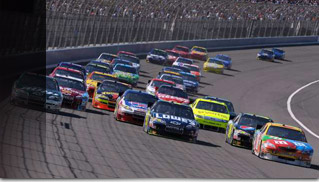 In 1920, the 18th Amendment banned the production and possession of alcohol in the United States. As law enforcement officials began to enforce “Prohibition”, alcohol producers had to be clever about how they transported their liquor. Specifically, to transport illegal alcohol, they needed vehicles that didn’t attract much attention so they would take ordinary “stock cars” and hot-rod them for high speed driving. When Prohibition ended in 1933, this widespread activity had became enormously popular and legal “stockcar racing” began. By the late ’40s, it had become a major form of entertainment. So popular, in fact, that NASCAR (The National Association for Stock Car Auto Racing) was formed in 1948 primarily to give formal definition to the sport.
In 1920, the 18th Amendment banned the production and possession of alcohol in the United States. As law enforcement officials began to enforce “Prohibition”, alcohol producers had to be clever about how they transported their liquor. Specifically, to transport illegal alcohol, they needed vehicles that didn’t attract much attention so they would take ordinary “stock cars” and hot-rod them for high speed driving. When Prohibition ended in 1933, this widespread activity had became enormously popular and legal “stockcar racing” began. By the late ’40s, it had become a major form of entertainment. So popular, in fact, that NASCAR (The National Association for Stock Car Auto Racing) was formed in 1948 primarily to give formal definition to the sport.
As NASCAR’s popularity boomed in the 1950s, automobile manufacturers began to get more involved in the sport by giving factory backing to individual drivers and teams. The sales staff at Sudbay Chrysler let us in on this: there was a popular motto in the early days of that caught on with the car dealers, it was “Win on Sunday, Sell on Monday”. It was simple concept, people liked to buy winning NASCAR vehicles. In fact, by the late 1960s most of the auto manufacturers were producing powerful cars and engines just for stock car racing purposes.
Stock car tracks are major part of the NASCAR experience today. It wasn’t always that way, though. In fact, during NASCAR’s inaugural season in 1949, all of the tracks were dirt! Just one year later, the Darlington Raceway opened its doors as the first fully paved track on the NASCAR circuit. At more than 1.25 miles in length, it technically classifies as a “superspeedway” and is still in use. Today, NASCAR’s premier track is the Daytona International Speedway. Daytona’s steeply banked turns set it apart from the rest when it opened in 1959.
NASCAR is the No.1 spectator sport in the United States today and the second most popular televised sport broadcast worldwide. It continues to grow in popularity and roughly 40 percent of its fan base is now female. As for the future, we will see but it would be imprudent to think that the sport will shrink in size anytime soon. Many have just discovered the sport and all the excitement that it contains. NASCAR is here for a long time and will certainly continue to grow in popularity.